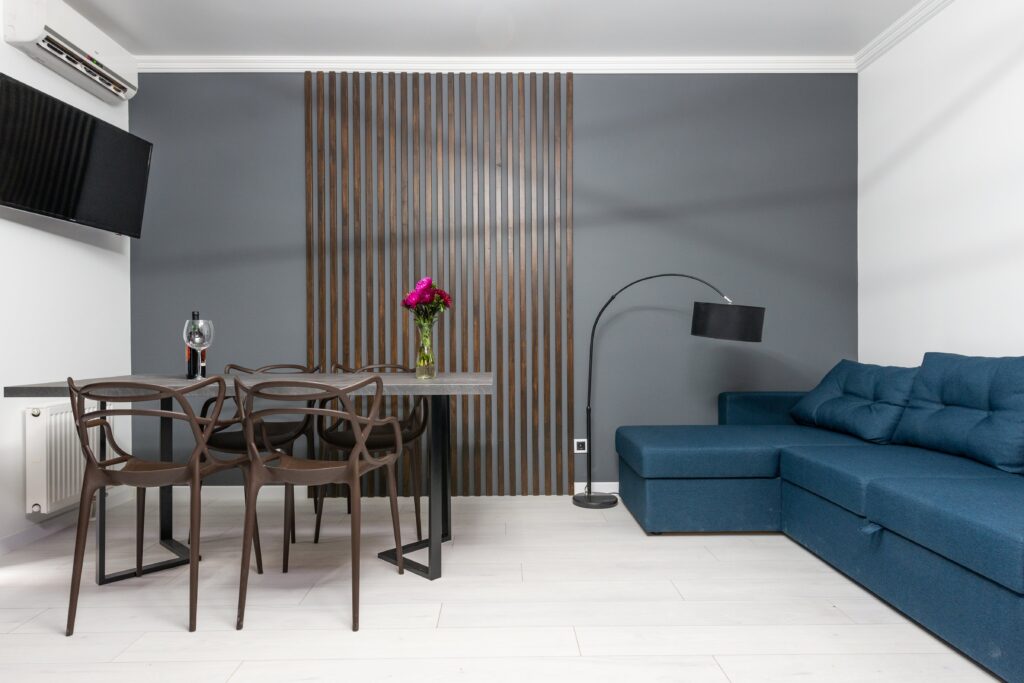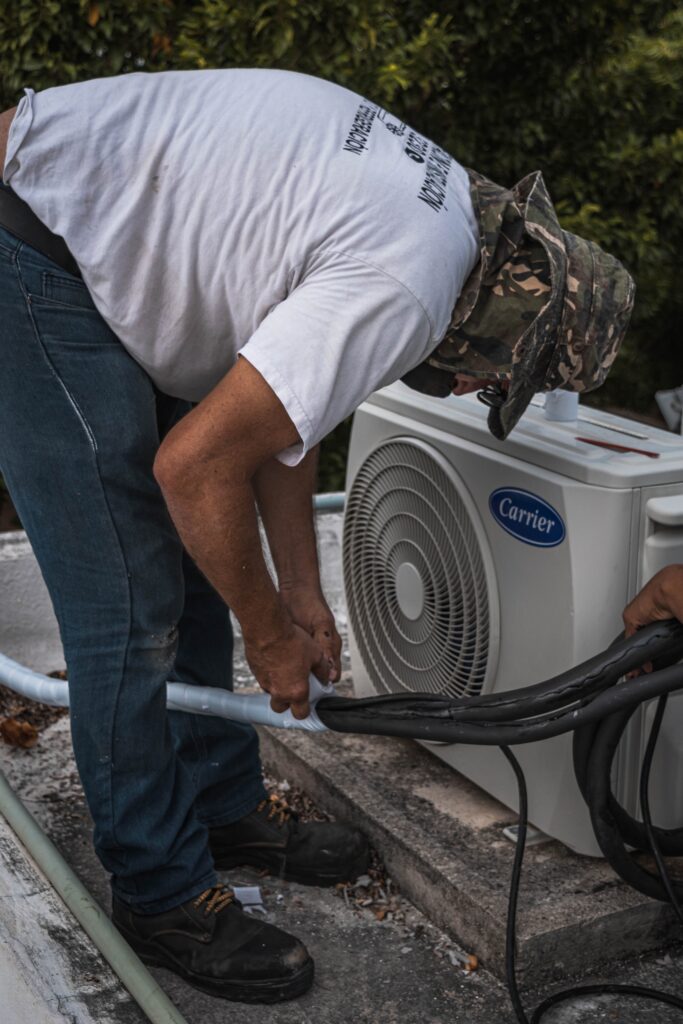What is the Cost of Installing a New AC Unit in 2023?

Typical Range: $3,884 – $7,931
On average, homeowners can expect to invest approximately $5,900 for the installation of a new air conditioning system. However, the total costs can vary between $3,884 and $7,931, contingent on factors like the unit’s size and type.
Air conditioning units, commonly referred to as AC units or air conditioners, have become an integral part of our modern lives. These cooling systems are designed to maintain comfortable indoor temperatures in homes, offices, and various other settings, especially during hot and humid weather. AC units work by removing heat from an enclosed space and circulating cool air, providing relief from sweltering temperatures and improving the overall quality of indoor living and working environments. Over the years, these systems have evolved, becoming more energy-efficient and technologically advanced, contributing to enhanced comfort and well-being while also playing a critical role in climate control and energy conservation. In this exploration of AC units, we will delve into their various types, functions, benefits, and considerations for selecting the right unit for your specific needs.
Factors Influencing the Cost of Air Conditioning Unit Installation
The cost of installing an air conditioning unit is influenced by several key factors. The type of AC unit you choose, such as central air systems, ductless mini-splits, or heat pumps, plays a significant role in determining installation costs. Larger units with higher cooling capacities tend to incur greater expenses, particularly if modifications to ductwork or electrical systems are required. Energy efficiency, often represented by the SEER rating, affects the initial cost but can lead to long-term savings.
The location and climate of your area, existing infrastructure like ductwork, labor costs, additional services like ductwork modifications or electrical work, and even the timing of installation all contribute to the overall expense. Brand, warranties, and government incentives can also impact costs. Selecting a reputable HVAC contractor is vital, as their expertise influences the final price. Careful consideration of these factors, coupled with obtaining quotes from local professionals, ensures an accurate estimate for your air conditioning unit installation.
Comparing the Costs: Replacing an Existing AC Unit vs. Installing a New AC Unit
Replacing an existing air conditioning (AC) unit and installing a completely new AC unit are two distinct approaches to addressing cooling needs in a residential or commercial space. Each option carries its own set of advantages and considerations, with cost being a significant factor in the decision-making process.
Existing AC Unit Replacement:
Replacing an existing AC unit typically involves removing the old, malfunctioning unit and installing a new one in the same location. This approach can be cost-effective if the existing ductwork and infrastructure are in good condition and compatible with the new unit. Some key points to consider include:
Lower Upfront Cost
Replacing an existing AC unit is often more budget-friendly than a completely new installation because it eliminates the need for significant modifications to your home’s HVAC system.
Efficiency Gains
A new AC unit is likely to be more energy-efficient and reliable than an older one, potentially resulting in lower energy bills and improved indoor comfort.
Compatibility
Ensure that the new unit is compatible with the existing infrastructure, including ductwork, electrical systems, and thermostats.
New AC Unit Installation:
Installing a new AC unit from scratch involves more extensive work and can be costlier, but it also offers unique advantages:
Customization
You have the opportunity to choose a system that perfectly fits your cooling needs and energy efficiency goals, potentially reducing long-term operational costs.
Advanced Features
New AC units often come with advanced features, such as smart thermostats and zoning capabilities, providing enhanced comfort and control.
Warranty and Longevity
A new installation typically comes with a warranty, ensuring peace of mind and a longer lifespan for the system.
When deciding between these options, it’s crucial to assess your specific circumstances, budget, and long-term goals. If your existing infrastructure is in good shape, replacing your AC unit can provide cost-effective and efficient cooling. On the other hand, a new AC unit installation allows for greater customization and the latest technology, potentially leading to increased comfort and energy savings. Consulting with HVAC professionals can help you make an informed choice that aligns with your unique cooling needs and financial considerations.

Labor Costs and Installation
The installation of an air conditioning unit is a critical aspect of the process and can significantly impact the overall cost. Labor costs vary based on the complexity of the installation, the type of unit, and the region. On average, labor costs can range from $1,500 to $5,000 or more. Here are some factors that influence labor costs:
Type of Unit:
Different types of AC units require varying levels of expertise and effort to install. For example, installing a central air system with ductwork can be more labor-intensive than setting up a window unit.
Location:
The region in which you live can impact labor costs. In areas with high demand for HVAC services, labor costs may be higher.
Existing Infrastructure:
If your home already has ductwork or an HVAC system in place, installing a compatible AC unit can be less costly than retrofitting a new system.
Additional Services:
Any additional work, such as ductwork installation or modifications, electrical upgrades, or obtaining permits, can add to the labor costs.
Contractor Selection:
The expertise and reputation of the HVAC contractor you choose can also affect labor costs. High-quality contractors may charge more for their services but ensure a professional and reliable installation.
Top 10 Air Conditioning Unit Brands
Selecting a reputable and reliable brand is a critical aspect of choosing an air conditioning unit that will provide long-term comfort, energy efficiency, and peace of mind. The brand you opt for can significantly influence the performance, durability, and overall satisfaction you experience with your AC unit. Here are the top 10 brands of AC units known for their quality and performance.
1. Carrier
2. Trane
3. Lennox
4. Mitsubishi Electric
5. Daikin
6. Fujitsu
7. Rheem
8. Goodman
9. York
10. WaterFurnace
These brands are trusted in the HVAC industry and have a track record of providing high-quality products. When choosing an AC unit, consider factors like energy efficiency, warranties, and customer reviews to make an informed decision.
Choosing the Right AC Unit for Your Needs

When selecting an air conditioning unit, consider factors such as the size of the space you need to cool, your budget, energy efficiency goals, and any specific requirements, such as zoning or smart features. Consulting with HVAC professionals can help you make an informed choice tailored to your unique cooling needs and financial considerations.
Top 5 most popular types of AC units and their average costs for purchase and installation:
1. Central Air Conditioning:
Average Cost: $3,000 to $7,000 or more.
Central air conditioning is a highly efficient and popular cooling solution for homes and businesses. This system operates by cooling air at a central location and distributing it throughout the building via a network of ducts. The benefits of central AC are numerous. Firstly, it provides consistent and uniform cooling to every room, ensuring a comfortable and enjoyable living or working environment. Additionally, central AC units are energy-efficient and often come with programmable thermostats, allowing users to control the temperature and save on utility bills. They also filter and dehumidify the air, improving indoor air quality and preventing moisture-related issues. Finally, central AC systems are quiet and discreet, as the noisy components are located outside the building.
2. Ductless Mini-Split System:
Average Cost: $2,500 to $7,500 or more.
A ductless mini-split system is a versatile and energy-efficient solution for cooling and heating spaces. Unlike central air conditioning systems that rely on ductwork, ductless mini-splits consist of an outdoor unit connected to one or more indoor air handlers. These systems offer several advantages, including zoned cooling, allowing users to set different temperatures for individual rooms, enhancing comfort and energy savings. They are known for their flexibility, making them suitable for both residential and commercial applications. Ductless mini-splits are often more energy-efficient than traditional systems, thanks to inverter-driven compressors that adjust the cooling or heating output to match the demand, resulting in consistent comfort and reduced energy consumption. Additionally, installation is relatively straightforward and minimally invasive, as there’s no need for ductwork, making them a popular choice for retrofitting older homes.
3. Window or Through-the-Wall Units:
Average Cost: $200 to $1,500 or more per unit.
Window or through-the-wall air conditioning units offer practical and budget-friendly solutions for cooling individual rooms or smaller spaces. These units are typically installed in a window or a hole through the wall, making installation relatively straightforward and cost-effective. They provide a degree of portability, allowing for easy relocation to different areas within the same building. Modern units come with energy-efficient features and programmable settings, contributing to reduced energy consumption and lower utility costs. Additionally, they don’t consume valuable floor space, making them a suitable choice for smaller rooms. Popular brands for these units include Frigidaire, LG, and Haier.
4. Heat Pumps:
Average Cost: $2,500 to $7,500 or more.
Heat pumps are efficient HVAC systems that provide both heating and cooling. There are two types: air source, which extracts heat from the air, and ground source (geothermal), which uses heat from the ground or water. They save energy, reduce costs, and are environmentally friendly. Air source heat pumps are cost-effective and suited for moderate climates, while geothermal heat pumps are pricier but highly efficient and environmentally friendly. Heat pumps offer year-round comfort, reduce emissions, and can be zoned for energy savings, making them a popular choice for homes and businesses. Your choice depends on your climate and budget.
5. Portable Air Conditioners:
Average Cost: $200 to $700 or more.
Portable air conditioners are small, movable cooling devices used in homes and offices. They are easy to move, need simple setup, and are affordable. These units come in different sizes, offer cooling and other functions, and can be controlled easily. They save energy and are good for small spaces. Common brands include Whynter, Honeywell, and Black+Decker. However, they may not cool large areas well and can be a bit noisy. If you need temporary or spot cooling, a portable air conditioner is a convenient choice.
These are some of the most popular AC unit types, offering a range of options to suit different cooling needs and budgets. Keep in mind that the costs can vary based on factors like capacity, energy efficiency, and installation requirements, so it’s advisable to consult with HVAC professionals for accurate pricing in your specific situation.
Additional Costs to Consider when purchasing or replacing an AC Unit:
Removal and Disposal Costs
If you’re replacing an old AC unit, consider the costs associated with removing and disposing of the old equipment in an environmentally responsible manner. The total cost of removing an old AC unit can vary significantly depending on the specific circumstances and your location. It’s essential to budget for these removal costs when planning for the replacement of your AC unit, as they are an integral part of the overall expenditure. Additionally, responsible disposal not only complies with environmental regulations but also contributes to a more sustainable and environmentally friendly approach to HVAC equipment removal.
Permits for AC Replacement
Before embarking on an AC replacement project, it’s crucial to understand the permit requirements in your local area. These requirements can vary widely depending on your location and the type of replacement you’re planning. Typically, local governments have specific regulations and codes in place to ensure the safety and environmental compliance of HVAC systems. To navigate this process effectively, it’s advisable to consult with an HVAC professional who can guide you through the permit application, inspections, and compliance processes. Keep in mind that permit costs can also vary, so it’s important to factor them into your budget when planning your AC replacement project.
Warranties for AC Units
Warranties play a pivotal role in ensuring peace of mind when it comes to your AC unit’s performance and longevity. AC units typically come with manufacturer’s warranties, which cover defects and issues that are not a result of improper installation or maintenance. These warranties often last between 5 to 10 years, providing a safety net against unexpected malfunctions. Additionally, you may have the option to purchase extended warranties, which offer more comprehensive coverage, including parts and labor. It’s essential to carefully review the terms and conditions of the warranty, as they outline what is covered, what is excluded, and any maintenance or registration requirements. In most cases, professional installation by a licensed HVAC technician is required to maintain warranty validity, and registering the warranty may be necessary to activate it.
AC installation costs in the top six states within the United States:
1. California: $4,500 to $7,500
2. Texas: $4,000 to $7,000
3. Florida: $4,000 to $7,000.
4. New York: $5,000 to $8,000
5. Pennsylvania: $4,500 to $7,500
6. Illinois: $4,500 and $7,500.
These are approximate cost ranges, and actual expenses can be influenced by a variety of factors, including the type of AC unit, installation complexity, and local labor rates. To get a more precise estimate for your AC installation project, it’s advisable to request quotes from HVAC professionals in your specific state and location.
Cost-saving tips for AC replacement and operation

1. Regular Maintenance – Schedule annual maintenance to keep your AC unit running efficiently and prolong its lifespan.
2. Energy-Efficient Models – Invest in an energy-efficient AC unit with a high SEER rating to reduce long-term operating costs while providing effective cooling.
3. Programmable Thermostats – Install a programmable or smart thermostat to create cooling schedules and save energy when you’re not at home.
4. Sealing and Insulation – Ensure your home is well-sealed, and consider adding insulation to prevent energy loss, enhancing efficiency.
5. Zone Cooling – Utilize zoned cooling if you have a ductless mini-split system to avoid cooling unused spaces efficiently.
6. Understanding Energy Costs – Gain a clear understanding of how your utility provider calculates energy costs to make informed decisions about your AC usage, ultimately saving on utility bills.
Cost-Effective Disposal Options for Old AC Units
Recycling Opportunities: Some components of old AC units, such as metal parts and certain materials, can often be recycled. While this doesn’t necessarily incur a direct cost, it’s important to consider the effort and potential expenses involved in recycling the equipment responsibly.
Donation or Resale: If your old AC unit is still in working condition, you may have the option to donate it or sell it. While this doesn’t involve a removal cost, it can offset some of the expenses associated with replacing the unit.
Trade-In Programs: Some HVAC companies offer trade-in programs where they accept your old AC unit as part of the purchase of a new unit. This can provide a discount on your new system, effectively reducing the overall cost of replacement.
Reuse and Repurpose: If your old AC unit is still in working condition but not suitable for your needs, you can explore options to repurpose it for other cooling needs. For example, you might use it in a garage or workshop.
Maintenance and Energy Efficiency
Regular maintenance is crucial for your AC’s efficiency and longevity. Tasks like changing air filters and cleaning coils maintain performance and indoor air quality. Proper refrigerant levels, secure electrical connections, and accurate thermostat calibration are essential for efficiency.
When it comes to energy efficiency, look at the SEER rating. Higher SEER ratings mean better efficiency. Modern energy-efficient units typically have SEER ratings from 14 to 25 or more. While they may cost more upfront, they lead to long-term energy savings and have a smaller environmental footprint by producing fewer greenhouse gas emissions. In summary, regular maintenance and investing in a high SEER-rated AC unit ensure optimal performance, energy savings, and eco-friendly cooling.
Air conditioning units have revolutionized our lives by providing the much-needed relief from the sweltering heat of summer. Whether you’re looking to cool a single room or your entire home, there are a variety of AC unit options available to meet your specific needs. By understanding the types of AC units, their costs, and the top brands in the market, you can make a well-informed decision to ensure your indoor comfort, energy efficiency, and overall well-being. Regular maintenance and energy-efficient choices can further enhance your AC unit’s performance, helping you stay cool and comfortable year-round.
FAQS
1. How often should I replace my AC unit?
AC units typically have a lifespan of 15-20 years. However, the actual replacement time depends on factors like usage, maintenance, and the specific unit. It’s best to consult with an HVAC professional for a more accurate assessment.
2. What is the difference between central AC and a ductless mini-split system?
Central AC cools an entire home using a network of ducts, while ductless mini-splits provide zoned cooling and don’t require ductwork. The choice depends on your home’s layout and cooling needs.
3. How can I improve the energy efficiency of my AC unit?
You can improve energy efficiency by maintaining the unit, regularly cleaning or changing filters, sealing any air leaks, and investing in an energy-efficient AC with a high SEER rating.
4. What is a SEER rating, and why is it important?
SEER (Seasonal Energy Efficiency Ratio) measures an AC unit’s energy efficiency. Higher SEER ratings indicate more efficient units, which can save you money on energy bills and reduce environmental impact.
5. What maintenance should I perform on my AC unit?
Regular maintenance includes cleaning or changing air filters, cleaning coils, checking refrigerant levels, tightening electrical connections, and calibrating the thermostat. Professional maintenance is recommended at least once a year.
6. How can I calculate the right AC unit size for my home?
Proper sizing depends on factors like your home’s square footage, insulation, and climate. A professional HVAC technician can perform a load calculation to determine the ideal unit size.
7. Are there tax credits or rebates for energy-efficient AC units?
Some regions offer tax credits or rebates for installing energy-efficient AC units. Check with local and federal government websites or consult with your HVAC professional for available incentives.
8. What should I do with my old AC unit when replacing it?
When replacing your old unit, consider responsible disposal or recycling options. Some HVAC companies offer trade-in programs, and local recycling centers may accept old units for responsible disposal.
9. How often should I change my AC’s air filters?
Air filters should be checked and, if necessary, changed every 1 to 3 months, depending on factors like usage, indoor air quality, and the type of filter used.
10. Can I install an AC unit myself?
While some may attempt DIY installations, it’s highly recommended to hire a professional HVAC technician for AC installations. They have the expertise to ensure proper sizing, installation, and compliance with local codes.
